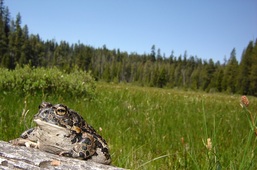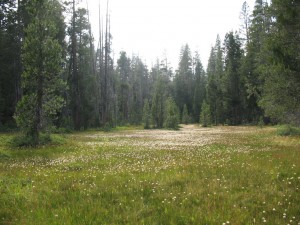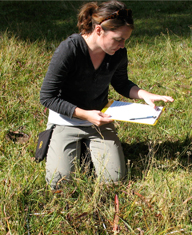 World-wide population declines have heightened concern for amphibian conservation on working landscapes. Across the Sierra Nevada’s national forest lands, where almost half of native amphibian species are considered at risk, permitted livestock grazing is a notably controversial agricultural activity. Cattle (Bos taurus) grazing is thought to degrade the quality, and thus reduce occupancy, of meadow breeding habitat for amphibian species such as the Yosemite toad (Anaxyrus [ = Bufo] canorus), a California Species of Concern and ESA threatened species.
World-wide population declines have heightened concern for amphibian conservation on working landscapes. Across the Sierra Nevada’s national forest lands, where almost half of native amphibian species are considered at risk, permitted livestock grazing is a notably controversial agricultural activity. Cattle (Bos taurus) grazing is thought to degrade the quality, and thus reduce occupancy, of meadow breeding habitat for amphibian species such as the Yosemite toad (Anaxyrus [ = Bufo] canorus), a California Species of Concern and ESA threatened species.
 Due to growing public concern surrounding cattle-wildlife interactions, USDA Forest Service-Pacific Southwest Region, UC Berkeley, and UC Davis partnered on the Yosemite Toad Adaptive Management (YTAM) Project to address scientific knowledge gaps on this management issue. The YTAM project encompassed multiple experimental approaches to investigate the potential impacts of cattle grazing on meadow habitat and the Yosemite toad.
Due to growing public concern surrounding cattle-wildlife interactions, USDA Forest Service-Pacific Southwest Region, UC Berkeley, and UC Davis partnered on the Yosemite Toad Adaptive Management (YTAM) Project to address scientific knowledge gaps on this management issue. The YTAM project encompassed multiple experimental approaches to investigate the potential impacts of cattle grazing on meadow habitat and the Yosemite toad.
Cattle Exclusion Experiments
We conducted controlled meadow-scale experiments to determine 1) breeding pool habitat (water quality and vegetative cover) responses and 2) Yosemite toad tadpoles and young of year responses to cattle exclusion treatments. Breeding pool habitat was monitored from 2006-2008 in 9 meadows (Sierra National Forest). Yosemite toad early life stages were monitored from 2006-2010 in 14 meadows (Sierra National and Stanislaus National Forests).
Results Highlights
- Nutrients ≥ 90% below levels of ecological concern.
- Turbidity, temperature, depth, and cover not significantly different among grazed and ungrazed treatments.
- No benefit to Yosemite toad presence or early life stages in ungrazed compared to grazed treatments (i.e., no trends due to grazing treatment).
Related Publications:
Roche, L.M., B. Allen-Diaz, D.J. Eastburn, K.W. Tate. 2012. Cattle grazing and Yosemite toad (Bufo canorus Camp) breeding habitat in Sierra Nevada meadows. Rangeland Ecology & Management 65:56-65. Read more.
S.K. Mcilroy, A.J. Lind, B. Allen-Diaz, L.M. Roche, W.E. Frost, R.L. Grasso, K.W. Tate. 2014. Determining the effects of cattle grazing treatments on Yosemite Toads (Anaxyrus [=Bufo] canorus) in montane meadows. PLOS ONE 8(11): e79263. Read more.
Cross-Sectional Survey
We also surveyed biotic and abiotic factors driving habitat use by livestock and Yosemite toad across Sierra Nevada mountain meadows. We collected data on toad occupancy, cattle utilization, plant community characteristics, and hydrologic conditions across 24 cattle-grazed meadows in the Sierra National Forest.
- Meadow wetness had a greater magnitude of influence on toad meadow occupancy than cattle grazing intensity.
- Cattle select for higher forage quality diets associated with relatively drier meadows.
- Toads more prevalent in wetter meadows, which provide more available breeding and rearing habitat.
Related Publications:
Roche, L.M., A.M. Latimer, D.J. Eastburn, K.W. Tate. 2012. Cattle grazing and sensitive wildlife species conservation in Sierra Nevada mountain meadows. PLOS ONE 7(4):e35734. Read more.
Collectively, these findings suggest cattle production and amphibian conservation can be compatible goals within this working landscape. These studies illustrate the importance of wet meadow habitat to conservation of Yosemite toads, and similarly meadow-dependent amphibian species.
Research funded by USDA Forest Service, Pacific Southwest Region.

